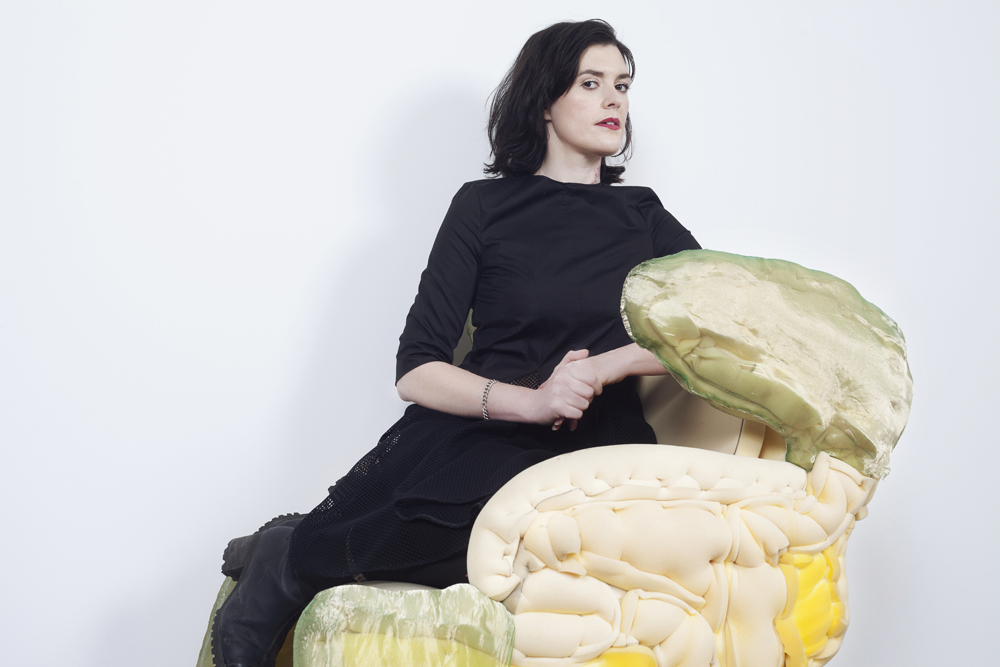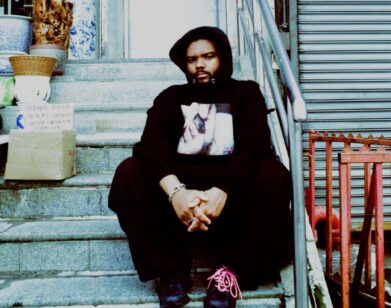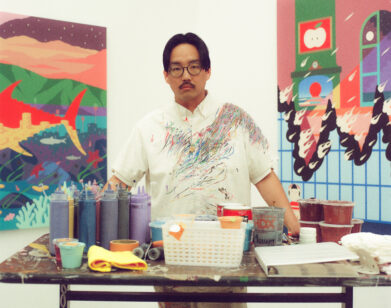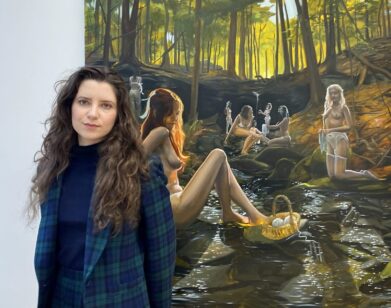On Her Own
BRIDGET DONAHUE IN NEW YORK, FEBRUARY 2015. PHOTOS BY JASON RODGERS. STYLING BY JESSI JACQ. HAIR/MAKEUP: KAVITA KAUL.
If you think having no formal education in art or art history, while previously serving as director of downtown art mecca Gavin Brown’s Enterprise and now owning a gallery seems suspicious, you’re not alone. For New York-based curator Bridget Donahue, however, that’s exactly what happened. After receiving her B.A. in anthropology and her M.A. in textiles, Donahue applied for various jobs, only one of which was in the gallery world. As fate would have it, she landed her first post-graduate position at the prestigious Gladstone Gallery, and the rest is history. Last night, Donahue welcomed guests into the second floor of 99 Bowery, the location of her self-titled gallery, for its inaugural show, “Origins of the Species,” featuring work by artist and filmmaker Lynn Hershman Leeson.
Rather than focusing on one specific medium, generation, or cultural era, Bridget Donahue will present exhibitions based upon artists’ intrigue and missions. “I met Lynn a couple years ago through hearing her speak and I remember being taken by her tone and what she had to say,” Donahue says, not mentioning the visual component of Hershaman Leeson’s work. Although the work on view provides powerful social commentary, this statement rings true for Donahue’s interests in artists; she is more interested in what they have to say than the works they make.
Directly following “Origins of the Species,” Donahue will host a benefit exhibition for publishing house Dancing Foxes, then a show focusing on multimedia artist Susan Cianciolo. In the fall, she will present works by extreme multi-hyphenate Martine Syms. Prior to the opening of her gallery, Donahue spoke with us about her upbringing and the unique path to her current position.
NAME: Bridget Donahue
BASED: New York
GROWING UP: I’m from Iowa City, Iowa. There’s a college town there, it’s got a great art school and writing program, but besides a university museum I didn’t grow up around gallery culture. Even going to college in Boston, there wasn’t a gallery scene. Having gone to school in the U.K. and going to London a lot, and I lived in Berlin for sixth months after that, then you really start understanding that art scene by way of being able to walk in and out of galleries that are free. You see things that are newer than museums. I think it was during those Berlin days, where it was exciting to enter in and out of free galleries and see things that were newer and edgier than the institution. That’s what began to pique that interest and thinking, “Oh wow, this a job.”
INTEREST AT FIRST SIGHT: The University of Iowa Museum of Art owned the Martha Rosler Semiotics of the Kitchen piece, which is a wild video where she goes through the alphabet with animated gestures and to each letter brandishes a different kitchen utensil. That was a really eye-opening video that didn’t seem or feel like art, but was a pretty memorable experience [growing up]. Also, this group show that was at the Norwich Gallery when I first went there, curated by Andrew Hunt called “Like Beads on an Abacus designed to Calculate Infinity,” that I remember was a first experience of what a curatorial project could be. It was based on a W.G. Sebald quote from this book [made into] this poetic alignment of artworks. That was a really transformative experience much later in life. I thought, “Oh wow, this counts. You can write this amazing essay and put together these works that are not so didactically connected.” That really shifted my way of thinking about things.
STROKE OF LUCK: I did a one-year M.A. in England, in Norwich, studying under this woman—it was a course on textiles—and the woman happened to infuse a lot of contemporary art examples, different parts of contemporary art history. That made me at least understand that there was this other world out there, another field to learn about, but I didn’t think I wanted to go to school more, and that’s when everything just lined up. It was such an anomaly. There was one art gallery job that I applied for and interviewed at, and it was that job at Gladstone [Gallery]. Everything else was textile based—industry, film, high-end consignment, textile archives, sourcing vintage textiles for different corporations. I remember people reacting like, “How did you get that job?” and I sort of didn’t understand how I did.
LEAVING GAVIN BROWN: I’d been working with Gavin Brown for five years and it was a great, supportive environment, but it was kind of the conversation of, “Where do we go from here?” He’s never someone who’s taken on a partner. He’s such a singular voice and vision that it felt like that was going to carry on and you could either figure out which way to work alongside him or start something anew. That turned into his encouragement in many ways, and my realization that now is the time, if any, to start something, when you don’t have much to lose and you have enough experience to start fresh. The longer you wait to see what happens, you have less of a way to take the plunge on your own.
ARTISTRY IN HISTORY: When I sent out an [email] blast, an artist that I know wrote back saying that this used to be his studio, which is amazing. Ken Nintzel is his name. He was in here between 2000 and 2005. Most recently it was a furniture store, but we peeled up all the carpet and there was tons of glue and we sanded it down. You can still see the embedded floor paint. I like that it’s not too precious. If anybody wants to paint the floor, drill into it, you know, it doesn’t feel scary to me. It’s already taken a beating.
WE THE PEOPLE: Everyone I’m interested in, no matter if they’re younger or older, they’ve stuck to this real mission they have on their own. It’s more about believing in that person, not really what they’re making. I’m not fetishizing one thing, like paintings or photography. It’s just really about this very defined, persistent, and dedicated research that these artists have done.
COLLECTORS AS TEACHERS: Everything I’ve learned is from artists, primarily, because that’s what drives a gallery—their activity, people that write about them, people that are interested in them. But really, learning from and listening to collectors, the best of which are such good lookers. They’ve looked forever at art; it’s what they do in their spare time. They commit a lot of support when the [artists] are really good, so just hearing reactions without reading a press release. Listening to artists and collectors, hearing what people react to, how an object functions on its own autonomy without somebody giving you a sheet on the dimensionality of the artist, paying attention to those elements helps you be able to turn around and speak on the artist’s behalf, or speak to that collector in a way that is in line with how they’ve reacted to things before.
FOR MORE INFORMATION, VISIT BRIDGET DONAHUE’S WEBSITE.







